Investigating the Impacts of Shame-Proneness on Students’ State Shame, Self-Regulation, and Learning
Abstract
1. Introduction
“I made…a 78. I remember thinking that—I kind of wanted to crawl into a hole…. But I kind of had the feeling like, ‘You did it again. You could have done better, and you screwed up again.’ So, despite the fact that I was highly disappointed, I was kind of expecting myself to feel disappointed. Does that make sense?”.[1] (p. 83)
1.1. State Shame
1.1.1. Lewis’ Appraisal Theory of Shame
1.1.2. Pekrun’s Control–Value Theory
1.2. Shame-Proneness
1.3. Self-Regulation
- Learners who receive the experimental manipulation will experience higher levels of state shame compared to learners who do not receive the manipulation.
- Learners with high shame-proneness will experience higher levels of state shame than students with low shame-proneness.
- Learners in the experimental manipulation who have high shame-proneness will learn significantly less than students who have low shame-proneness.
- Learners with high shame-proneness will have significantly lower self-regulation than students with low shame-proneness.
2. Materials and Methods of Study 1
2.1. Power Analysis
2.2. Study 1 Participants
2.3. Materials
2.3.1. Test of Self-Conscious Affect (TOSCA-3)
2.3.2. Self-Regulated Learning Self-Report Survey (SRL-SRS)
2.3.3. Experiential Shame Scale (ESS)
2.3.4. Pretest/Posttest
2.3.5. Aptitude Test
2.4. Procedure
“During this portion of the study, you will be asked to complete a series of problems. These are problems that, as a college student, should not be extremely challenging for you. Additionally, it is important to note that the upcoming test has been shown to predict your overall intelligence. To recreate a scenario that would match an actual testing environment, you will have 30 min to complete the test. After you submit the test, instructions will appear on the screen that will let you know the next steps you will need to take in this study. Please let the experimenter know if you have any questions at this time. Thank you again for your participation!”
“Your combined score on the test was: 40%. The average [school name] student scored 90%. Please let the experimenter know your score so it can be cataloged.”
“You have now completed this portion of the study. Please let the experimenter know you are ready to proceed.”
3. Results of Study 1
3.1. State Shame and Shame-Proneness
3.2. Learning-Gains
3.3. Shame-Proneness and Self-Regulation
3.4. Summary of Study 1
4. Materials and Methods of Study 2
4.1. Participants
4.2. Materials
4.2.1. Pretest/Posttest
4.2.2. Aptitude Test
4.3. Procedure
“During this portion of the study, you will be asked to complete a series of problems. These are problems that, as a college student, should not be extremely challenging for you. Additionally, it is important to note that the upcoming test has been shown to predict your overall intelligence. To recreate a scenario that would match an actual testing environment, you will have 30 min to complete the test. After you submit the test, instructions will appear on the screen that will let you know the next steps you will need to take in this study. Please let the experimenter know if you have any questions at this time. Thank you again for your participation!”
“Your combined score on the test was: 40%. The average [school name] student scored 90%. Please let the experimenter know your score so it can be cataloged.”
“You have now completed this portion of the study. Please let the experimenter know you are ready to proceed.”
You are being presented with a hypermedia encyclopedia, which contains textual information, static diagrams, and digitized video clips. We are trying to learn more about how students use hypermedia environments to learn about the circulatory system. Your task is to learn all you can about the circulatory system in 30 min. Make sure you learn about the different parts and their purpose, how they work individually and together, and how they support the human body. I’ll be here if anything goes wrong with the computer or the equipment. Thank you again for your participation!
5. Results of Study 2
5.1. State Shame and Shame-Proneness
5.2. State Shame, Shame-Proneness, and Learning Gains
5.3. Self-Regulation
6. General Discussion
6.1. Shame-Proneness and Self-Verification
6.2. Shame-Proneness and Self-Regulation
6.3. Shame-Proneness and Learning
6.4. Suggestions for Interventions
6.4.1. Attributional Retraining
6.4.2. Self-Compassion
Involves being touched by and open to one’s own suffering, not avoiding or disconnecting from it, and generating the desire to alleviate one’s suffering and to heal oneself with kindness. Self-compassion also involves offering nonjudgmental understanding of one’s pain, inadequacies, and failures so that one’s experience is seen as part of the larger human experience.(p. 87)
6.4.3. Online Education
7. Conclusions
Author Contributions
Funding
Institutional Review Board Statement
Informed Consent Statement
Data Availability Statement
Conflicts of Interest
Appendix A
| Effect Size (d) | Power | Minimum Sample Size in Total |
|---|---|---|
| 0.8 | 0.8 | 52 |
| Number of Groups | Numerator df | Effect size (f) | Power | Minimum Sample Size in Total |
|---|---|---|---|---|
| 4 | 1 | 0.4 | 0.8 | 52 |
Appendix B
Q. What Is the Amplitude of the Wave Represented in the Diagram?
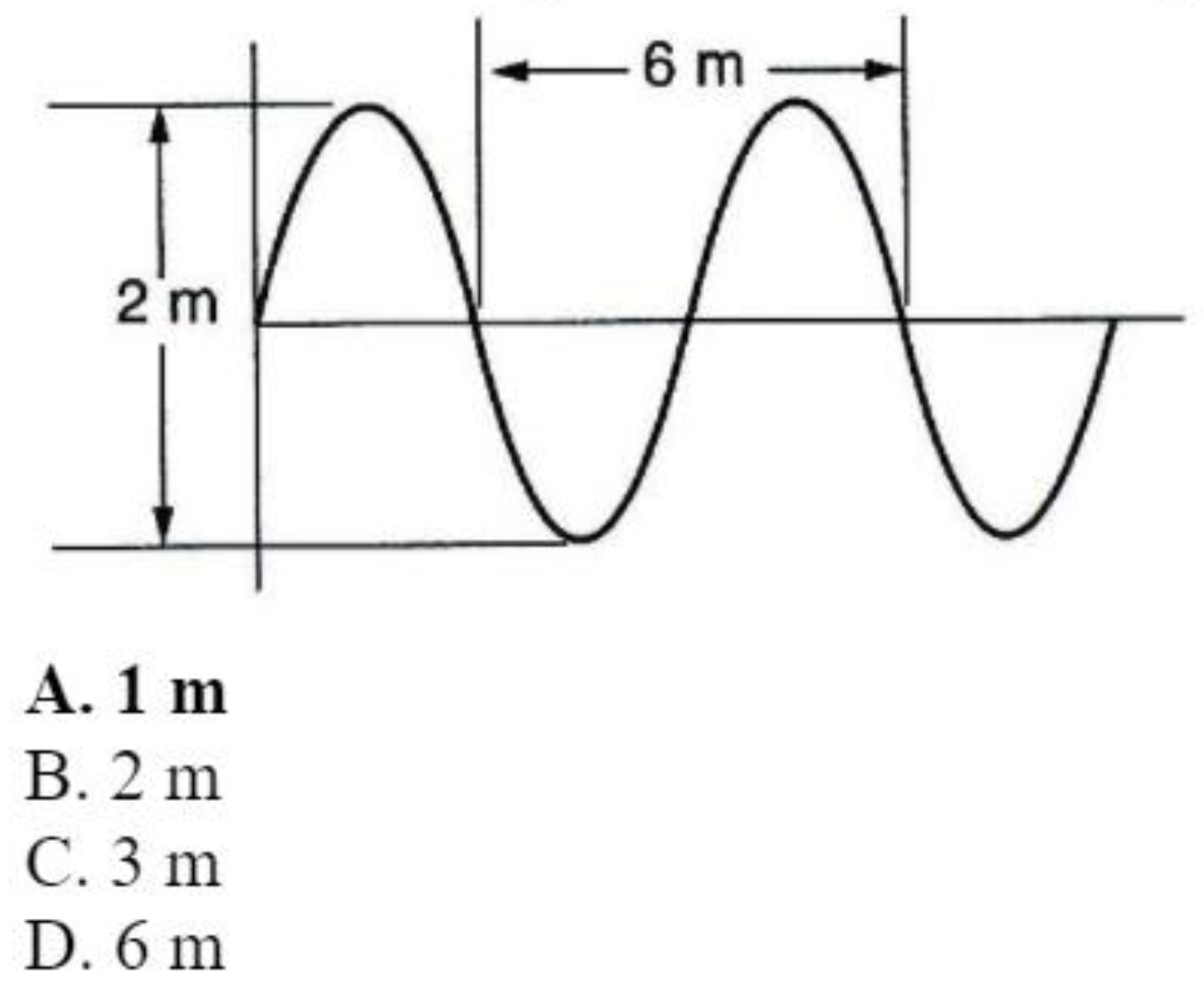
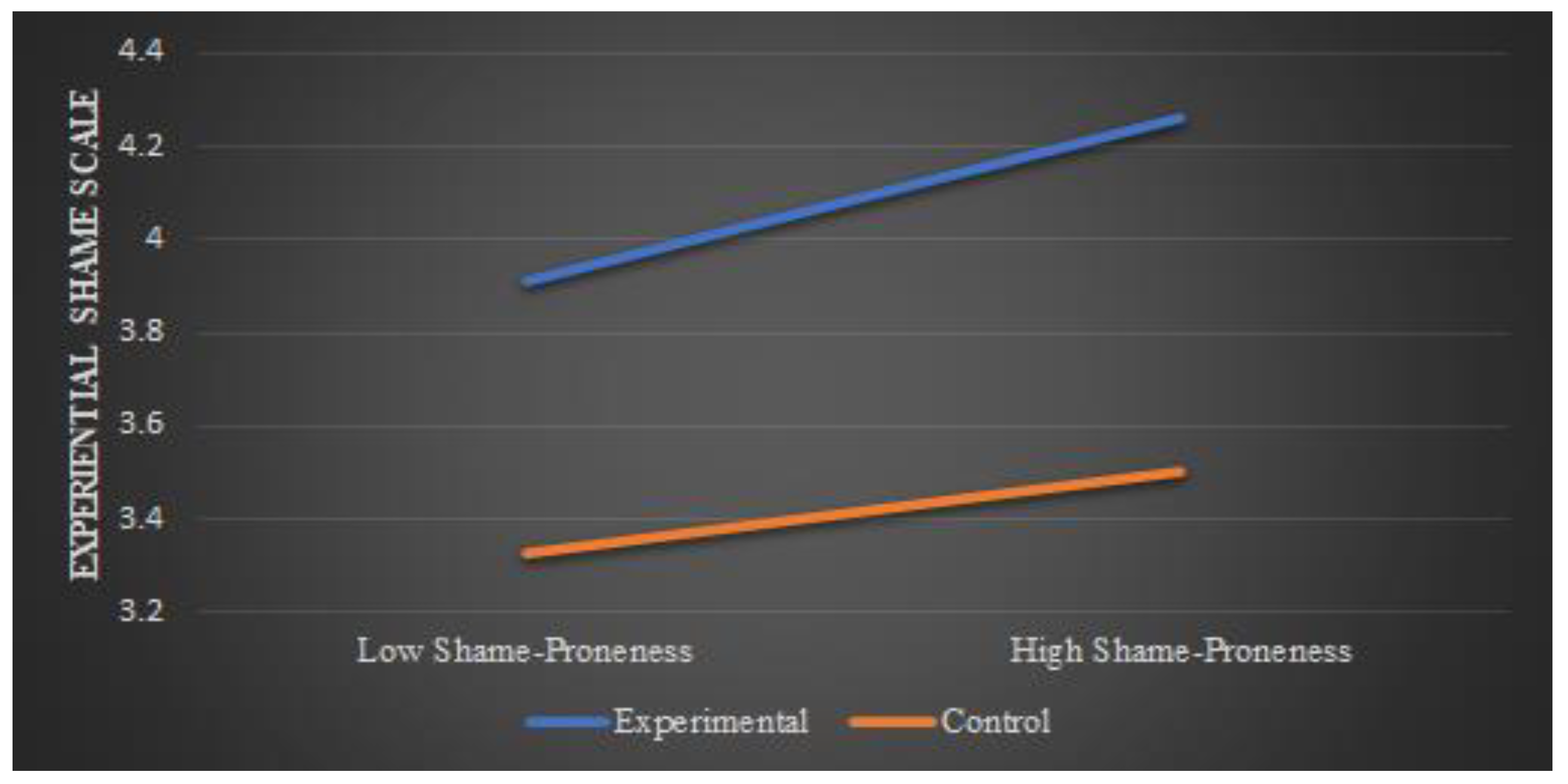
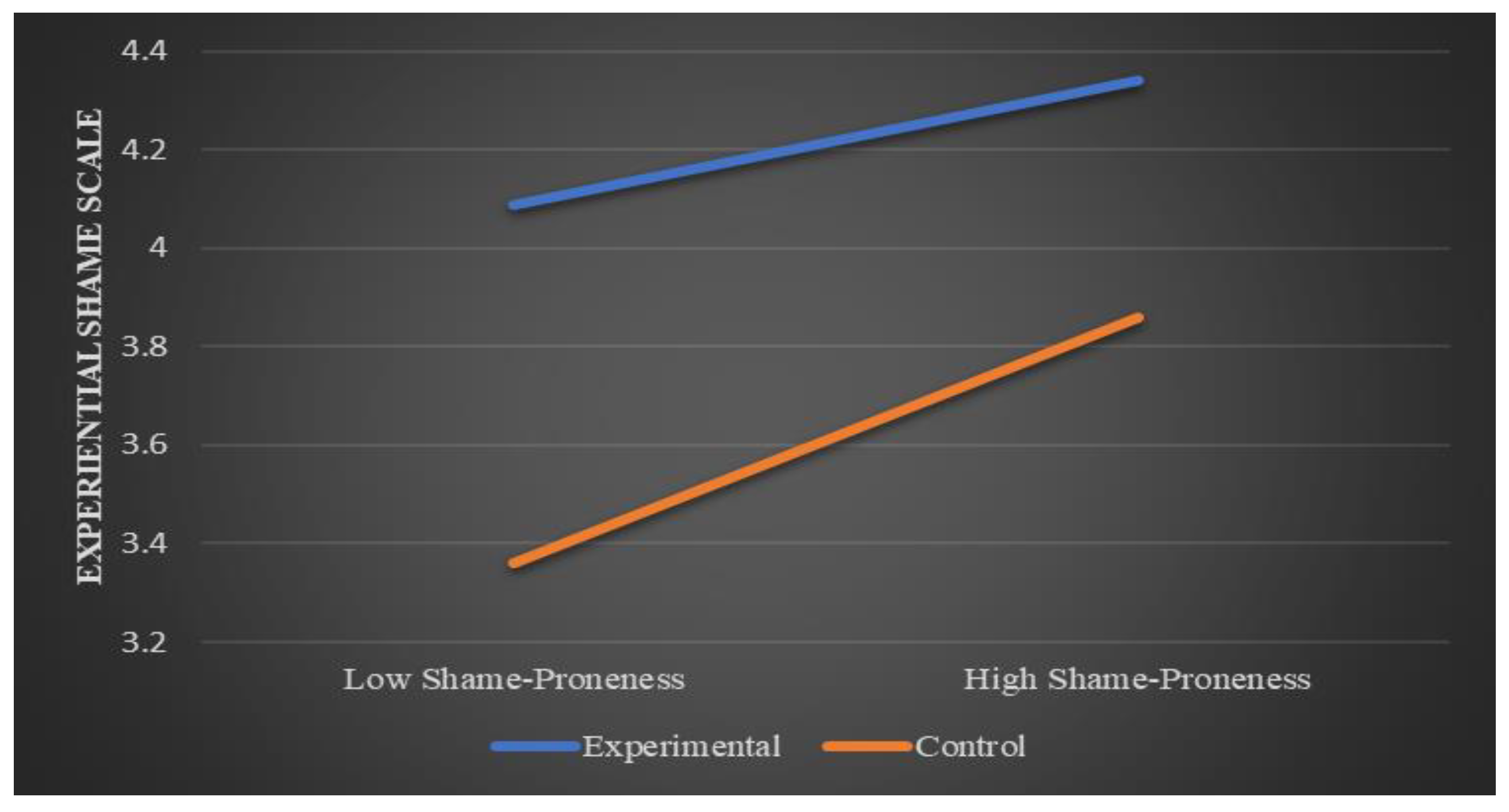
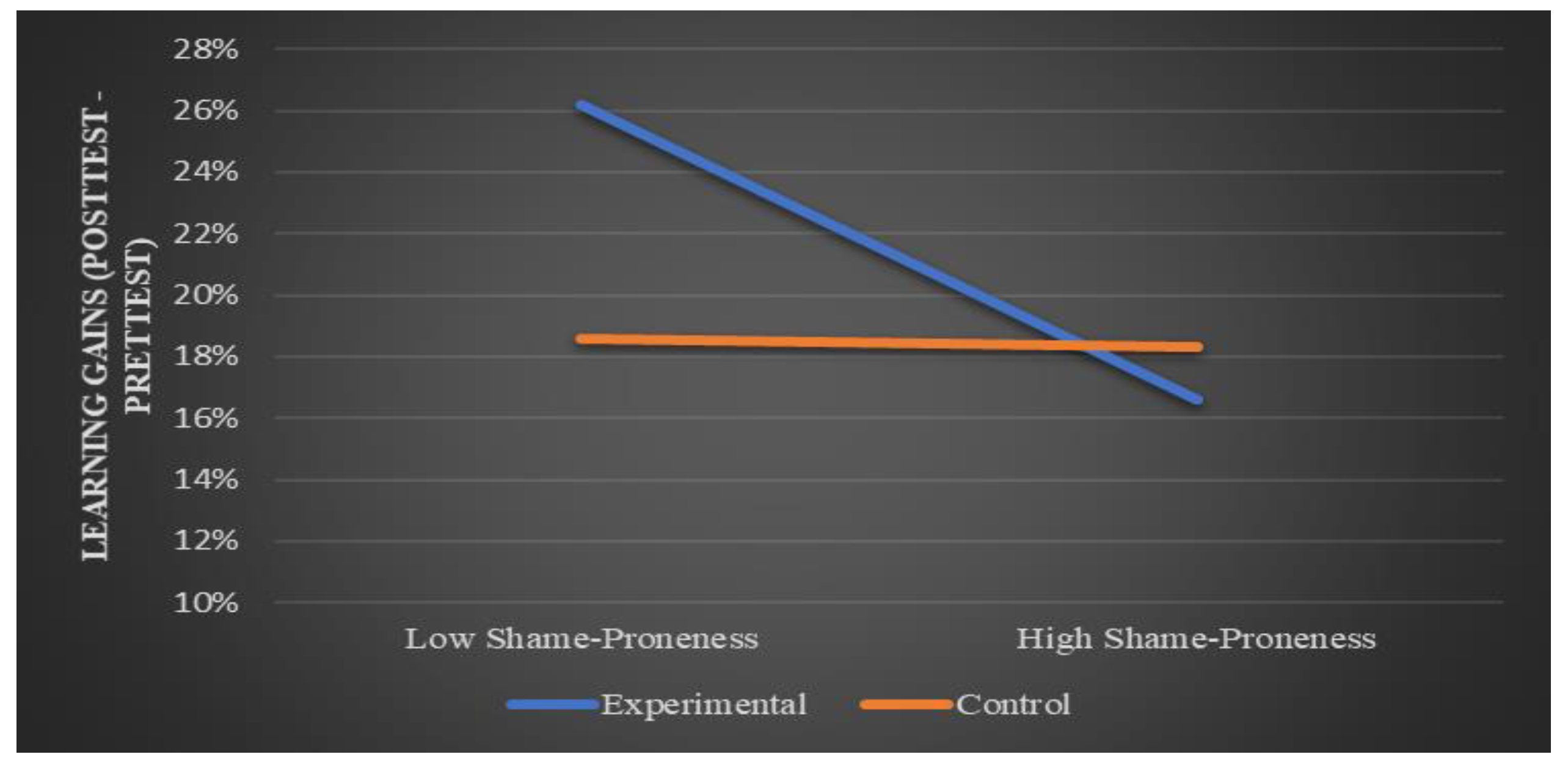
References
- Turner, J.E.; Husman, J.; Schallert, D.L. The importance of students’ goals in their emotional experience of academic failure: Investigating the precursors and consequences of shame. Educ. Psychol. 2002, 37, 79–89. [Google Scholar] [CrossRef]
- Turner, J.E.; Husman, J. Emotional and cognitive self-regulation following academic shame. J. Adv. Acad. 2008, 20, 138–173. [Google Scholar] [CrossRef]
- Tangney, J.P.; Dearing, R.L. Shame and Guilt; Guilford: New York, NY, USA, 2002. [Google Scholar]
- Tangney, J.P.; Wagner, P.E.; Hill-Barlow, D.; Marschall, D.E.; Gramzow, R. Relation of shame and guilt to constructive versus destructive responses to anger across the lifespan. J. Person. Soc. Psychol. 1996, 70, 797–809. [Google Scholar] [CrossRef] [PubMed]
- Budiarto, Y.; Helmi, A.F. Shame and Self-Esteem: A Meta-Analysis. Eur. J. Psychol. 2021, 17, 131–145. [Google Scholar] [CrossRef] [PubMed]
- Kämmerer, A. The Scientific Underpinnings and Impacts of Shame. Scientific American. 2019. Available online: https://www.scientificamerican.com/article/the-scientific-underpinnings-and-impacts-of-shame/ (accessed on 28 November 2023).
- Stuewig, J.; Tangney, J.P.; Kendall, S.; Folk, J.B.; Meyer, C.R.; Dearing, R.L. Children’s Proneness to Shame and Guilt Predict Risky and Illegal Behaviors in Young Adulthood. Child Psychiatry Hum. Dev. 2015, 46, 217–227. [Google Scholar] [CrossRef] [PubMed]
- Tignor, S.M.; Colvin, C.R. The Interpersonal Adaptiveness of Dispositional Guilt and Shame: A Meta-Analytic Investigation. J. Pers. 2017, 85, 341–363. [Google Scholar] [CrossRef] [PubMed]
- Galmiche, D. The Role of Shame in Language Learning. J. Lang. Texts Soc. 2018, 2, 99–129. [Google Scholar]
- Huff, J.L.; Okai, B.; Shanachilubwa, K.; Sochacka, N.W.; Walther, J. Unpacking professional shame: Patterns of white, male engineering students living in and out of threats to their identities. J. Eng. Educ. 2021, 110, 414–436. [Google Scholar] [CrossRef]
- Teimouri, Y. Differential roles of shame and guilt in L2 learning: How bad is bad? Mod. Lang. J. 2018, 102, 632–652. [Google Scholar] [CrossRef]
- Shuman, V.; Scherer, K.R. Concepts and structures of emotions. In International Handbook of Emotions in Education; Pekrun, R., Linnenbrink-Garcia, L., Eds.; Routledge/Taylor & Francis Group: New York, NY, USA, 2014; pp. 13–35. [Google Scholar]
- Bynum IV, W.E.; Varpio, L.; Lagoo, J.; Teunissen, P.W. ‘I’m Unworthy of Being in This Space’: The Origins of Shame in Medical Students. Med. Educ. 2021, 55, 185–197. [Google Scholar] [CrossRef]
- Lewis, M. Self-conscious emotions: Embarrassment, pride, shame, and guilt. In Handbook of Emotions; Lewis, M., Haviland-Jones, J.M., Barrett, L.F., Eds.; The Guilford Press: New York, NY, USA, 2008; pp. 742–756. [Google Scholar]
- Tracy, J.L.; Robins, R.W. Putting the self in the self-conscious: A theoretical model. Psychol. Inq. 2004, 15, 103–125. [Google Scholar] [CrossRef]
- Leach, C.W. Understanding Shame and Guilt. In Handbook of the Psychology of Self-Forgiveness; Woodyatt, L., Worthington, E., Jr., Wenzel, M., Griffin, B., Eds.; Springer: Cham, Switzerland, 2017. [Google Scholar]
- Probyn, E. Blush: Faces of Shame; Minnesota University Press: Minneapolis, MN, USA, 2005. [Google Scholar]
- Turner, J.E. Researching state shame with the experiential shame scale. J. Psychol. 2014, 148, 577–601. [Google Scholar] [CrossRef] [PubMed]
- Boekaerts, M. Being concerned with well-being and with learning. Educ. Psychol. 1993, 28, 149–167. [Google Scholar] [CrossRef]
- Karimi, M.N.; Fallah, N. Academic Burnout, Shame, Intrinsic Motivation, and Teacher Affective Support Among Iranian EFL Learners: A Structural Equation Modeling Approach. Curr. Psychol. 2021, 40, 2026–2037. [Google Scholar] [CrossRef]
- Pekrun, R. The control-value theory of achievement emotions: Assumptions, corollaries, and implications for educational research and practice. Educ. Psychol. Rev. 2006, 18, 315–341. [Google Scholar] [CrossRef]
- Pekrun, R.; Frenzel, A.C.; Goetz, T.; Perry, R.P. The control-value theory of achievement emotions: An integrative approach to emotions in education. In Emotion in Education; Elsevier Academic Press: Amsterdam, The Netherlands, 2007; pp. 13–36. [Google Scholar]
- Pekrun, R.; Marsh, H.W.; Elliot, A.J.; Stockinger, K.; Perry, R.P.; Vogl, E.; Goetz, T.; Van Tilburg, W.A.; Lüdtke, O.; Vispoel, W.P. A three-dimensional taxonomy of achievement emotions. J. Pers. Soc. Psychol. 2023, 124, 145. [Google Scholar] [CrossRef] [PubMed]
- Pineles, S.L.; Street, A.E.; Koenen, K.C. The differential relationships of shame-proneness and guilt-proneness to psychological and somatization symptoms. J. Soc. Clin. Psychol. 2006, 6, 688. [Google Scholar] [CrossRef]
- Tangney, J.P.; Wagner, P.; Gramzow, R. Proneness to shame, proneness to guilt, and psychopathology. J. Abnorm. Psychol. 1992, 101, 469–478. [Google Scholar] [CrossRef]
- Thompson, T.; Altmann, R.; Davidson, J. Shame-proneness and achievement behaviour. Person. Indiv. Differ. 2004, 36, 613–627. [Google Scholar] [CrossRef]
- Boekaerts, M.; Pekrun, R. Emotions and Emotion Regulation in Academic Settings. In Handbook of Educational Psychology; Corno, L., Anderman, E.M., Eds.; Routledge/Taylor & Francis Group: New York, NY, USA, 2016; pp. 76–90. [Google Scholar]
- Meinhardt, J.; Pekrun, R. Emotion and memory. In Handbook of Emotions, 2nd ed.; Lewis, M., Haviland-Jones, J.M., Eds.; Guilford Press: New York, NY, USA, 2003; pp. 476–490. [Google Scholar]
- Boekaerts, M. Self-regulation and effort investment. In Handbook of Child Psychology; Renninger, K.A., Sigel, I.E., Damon, W., Lerner, R.M., Eds.; John Wiley & Sons, Inc.: Hoboken, NJ, USA, 2006; Volume 4, pp. 345–377. [Google Scholar]
- Zimmerman, B.J. Development and adaptation of expertise: The role of self-regulatory processes and beliefs. In The Cambridge Handbook of Expertise and Expert Performance; Cambridge University Press: Cambridge, UK, 2006; pp. 705–722. [Google Scholar]
- Zimmerman, B.J. Investigating self-regulation and motivation: Historical background, Methodological developments, and future prospects. Am. Educ. Res. J. 2008, 45, 166–183. [Google Scholar] [CrossRef]
- Alotaibi, K.; Tohmaz, R.; Jabak, O. The relationship between self-regulated learning and academic achievement for a sample of community college students at King Saud University. Educ. J. 2017, 6, 28–37. [Google Scholar] [CrossRef][Green Version]
- Ergen, B.; Kanadli, S. The effect of self-regulated learning strategies on academic achievement: A meta-analysis study. Eurasian J. Educ. Res. 2017, 17, 55–74. [Google Scholar] [CrossRef]
- Nota, L.; Soresi, S.; Zimmerman, B.J. Self-regulation and academic achievement and resilience: A longitudinal study. Int. J. Educ. Res. 2004, 41, 198–215. [Google Scholar] [CrossRef]
- Schunk, D.H. Commentary on self-regulation in school contexts. Learn. Instruc. 2005, 15, 173–177. [Google Scholar] [CrossRef]
- Lickel, B.; Kushlev, K.; Savalei, V.; Matta, S.; Schmader, T. Shame and the motivation to change the self. Emotion 2014, 14, 1049–1061. [Google Scholar] [CrossRef] [PubMed]
- Tangney, J.P.; Dearing, R.L.; Wagner, P.E.; Gramzow, R. The Test of Self-Conscious Affect-3 (TOSCA-3); George Mason University Press: Fairfax, VA, USA, 2000. [Google Scholar]
- Toering, T.; Elferink-Gemser, M.T.; Jonker, L.; van Heuvelen, M.J.G.; Visscher, C. Measuring self-regulation in a learning context: Reliability and validity of the Self-Regulation of Learning Self-Report Scale (SRL-SRS). Int. J. Sport Exerc. Psychol. 2012, 10, 24–38. [Google Scholar] [CrossRef]
- Zimmerman, B.J.; Schunk, D.H. Handbook of Self-Regulation of Learning and Performance; Routledge/Taylor & Francis Group: New York, NY, USA, 2011; pp. 1–12. [Google Scholar]
- Bynum, W.E., IV; Uijtdehaage, S.; Artino, A.R., Jr.; Fox, J.W. The Psychology of Shame: A Resilience Seminar for Medical Students. MedEdPORTAL 2020, 16, 11052. [Google Scholar] [CrossRef] [PubMed]
- Sullins, J.; Console, K.; Henrichson, C.; Denton, R.; Roberts, S.; Howell, K. The First Step in Harnessing the Self-Conscious Emotions: A Quantitative Exploration of Shame. In Proceedings of the CogSci, Madison, WI, USA, 25–28 July 2018. [Google Scholar]
- IBM. SPSS Statistics; IBM: Chicago, IL, USA, 2022; Available online: https://www.ibm.com/support/pages/release-notes-ibm®-spss®-statistics-29 (accessed on 2 January 2024).
- Hall, N.C.; Perry, R.P.; Chipperfield, J.G.; Clifton, R.A.; Haynes, T.L. Enhancing primary and secondary control in achievement settings through writing–based attributional retraining. J. Soc. Clin. Psychol. 2006, 25, 361–391. [Google Scholar] [CrossRef]
- Bilodeau, C.; Savard, R.; Lecomte, C. Examining Supervisor and Supervisee Agreement on Alliance: Is Shame a Factor? Can. J. Couns. Psychother. 2010, 44, 272–282. [Google Scholar]
- Swann, W.B. Self-Verification: Bringing Social Reality into Harmony with the Self. In Social Psychological Perspectives on the Self, 2nd ed.; Suls, J., Greenwald, A.G., Eds.; Lawrence Erlbaum Associates: Mahwah, NJ, USA, 1983; Volume 2, pp. 33–66. [Google Scholar]
- Swann, W.B.; Brooks, M. Why threats trigger compensatory reactions: The need for coherence and quest for self-verification. Soc. Cognit. 2012, 30, 758–777. [Google Scholar] [CrossRef]
- Pekrun, R.; Goetz, T.; Titz, W.; Perry, R.P. Academic emotions in students’ self-regulated learning and achievement: A program of qualitative and quantitative research. Educ. Psychol. 2002, 37, 91–105. [Google Scholar] [CrossRef]
- North, R.J.; Swann, W.B., Jr. Self-verification 360: Illuminating the light and dark sides. Self Identity 2009, 8, 131–146. [Google Scholar] [CrossRef]
- Prislin, R.; Wood, W. Social Influence in Attitudes and Attitude Change. In The Handbook of Attitudes; Albarracín, D., Johnson, B.T., Zanna, M.P., Eds.; Lawrence Erlbaum Associates Publishers: Mahwah, NJ, USA, 2005; pp. 671–705. [Google Scholar]
- Tang, D.; Fan, W.; Zou, Y.; George, R.A.; Arbona, C.; Olvera, N.E. Self-Efficacy and Achievement Emotions as Mediators between Learning Climate and Learning Persistence in College Calculus: A Sequential Mediation Analysis. Learn. Individ. Differ. 2021, 92, 102094. [Google Scholar] [CrossRef]
- Martin, A.J.; Nejad, H.G.; Colmar, S.; Liem, G.A.D. Adaptability: How students’ responses to uncertainty and novelty predict their academic and non-academic outcomes. J. Educ. Psychol. 2013, 105, 728. [Google Scholar] [CrossRef]
- Collie, R.J.; Martin, A.J. Students’ adaptability in mathematics: Examining self-reports and teachers’ report and links with engagement and achievement outcomes. Contemp. Educ. Psychol. 2017, 49, 355–366. [Google Scholar] [CrossRef]
- Van Rooij, E.C.; Jansen, E.P.; van de Grift, W.J. First-year university students’ academic success: The importance of academic adjustment. Eur. J. Psychol. Educ. 2018, 33, 749–767. [Google Scholar] [CrossRef]
- Lynch, D.J. Motivational factors, learning strategies and resource management as predictors of course grades. Coll. Stud. J. 2006, 40, 423–429. [Google Scholar]
- Richardson, M.; Abraham, C.; Bond, R. Psychological correlates of university students’ academic performance: A systematic review and meta-analysis. Psychol. Bull. 2012, 138, 353. [Google Scholar] [CrossRef] [PubMed]
- Martinko, M.J.; Mackey, J.D. Attribution Theory: An Introduction to the Special Issue. J. Organ. Behav. 2019, 40, 523–527. [Google Scholar] [CrossRef]
- Weiner, B. An attributional theory of achievement motivation and emotion. Psychol. Rev. 1985, 92, 548. [Google Scholar] [CrossRef]
- Haynes, T.L.; Daniels, L.M.; Stupnisky, R.H.; Perry, R.P.; Hladkyj, S. The effect of attributional retraining on mastery and performance motivation among first-year college students. Basic Appl. Soc. Psychol. 2008, 30, 198–207. [Google Scholar] [CrossRef]
- Azemi, K.; Garavand, Y.; Arabzadeh, M. The Effect of Attributional Retraining Program on Learned Helplessness and Achievement Motivation in Students with Low Academic Achievement in Middle School. Q. J. Soc. Work. 2021, 9, 21–32. [Google Scholar]
- Boese, G.D.; Stewart, T.L.; Perry, R.P.; Hamm, J.M. Assisting failure-prone individuals to navigate achievement transitions using a cognitive motivation treatment (attributional retraining). J. Appl. Soc. Psychol. 2013, 43, 1946–1955. [Google Scholar] [CrossRef]
- Hamm, J.M.; Perry, R.P.; Clifton, R.A.; Chipperfield, J.G.; Boese, G.D. Attributional retraining: A motivation treatment with differential psychosocial and performance benefits for failure-prone individuals in competitive achievement settings. Basic Appl. Soc. Psychol. 2014, 36, 221–237. [Google Scholar] [CrossRef]
- Neff, K. Self-compassion: An alternative conceptualization of a healthy attitude toward oneself. Self Identity 2003, 2, 85–101. [Google Scholar] [CrossRef]
- Neely, M.E.; Schallert, D.L.; Mohammed, S.S.; Roberts, R.M.; Chen, Y.J. Self-kindness when facing stress: The role of self-compassion, goal regulation, and support in college students’ well-being. Motiv. Emot. 2009, 33, 88–97. [Google Scholar] [CrossRef]
- Neff, K.D.; Hsieh, Y.P.; Dejitterat, K. Self-compassion, achievement goals, and coping with academic failure. Self Identity 2005, 4, 263–287. [Google Scholar] [CrossRef]
- Martin, R.D.; Kennett, D.J.; Hopewell, N.M. Examining the importance of academic-specific self-compassion in the academic self-control model. J. Soc. Psychol. 2019, 159, 676–691. [Google Scholar] [CrossRef]
- Neff, K.D.; Kirkpatrick, K.L.; Rude, S.S. Self-compassion and adaptive psychological functioning. J. Res. Pers. 2007, 41, 139–154. [Google Scholar] [CrossRef]
- Shapiro, S.L.; Astin, J.A.; Bishop, S.R.; Cordova, M. Mindfulness-based stress reduction for health care professionals: Results from a randomized trial. Int. J. Stress Manag. 2005, 12, 164. [Google Scholar] [CrossRef]
- National Center for Education Statistics. U.S. Education: During the Pandemic and Beyond; National Center for Education Statistics: Washington, DC, USA, 2022. Available online: https://nces.ed.gov/surveys/annualreports/pdf/Education-Covid-time.pdf (accessed on 2 January 2024).
- Cameron, M.; Lacy, T.A.; Siegel, P.; Wu, J.; Wilson, A.; Johnson, R.; Burns, R.; Wine, J. 2019–20 National Postsecondary Student Aid Study (NPSAS:20): First Look at the Impact of the Coronavirus (COVID-19) Pandemic on Undergraduate Student Enrollment, Housing, and Finances (Preliminary Data) (NCES 2021-456). U.S. Department of Education, National Center for Education Statistics. 2021. Available online: https://nces.ed.gov/pubs2021/2021456.pdf (accessed on 2 January 2024).
- Anwar, A.; Barut, A.; Pala, F.; Kilinc-Ata, N.; Kaya, E.; Lien, D.T.Q. A Different Look at the Environmental Kuznets Curve from the Perspective of Environmental Deterioration and Economic Policy Uncertainty: Evidence from Fragile Countries. Environ. Sci. Pollut. Res. 2023, 1–20. [Google Scholar] [CrossRef]
- Collazos, N.E.; Obregón, T.A.M.; Pepicano, M.A.C.; Mosquera, F.E.C. Estilos de Vida en Estudiantes Universitarios de un Programa Académico de Salud. Enferm. Investig. 2021, 6, 12–18. [Google Scholar] [CrossRef]
- Stephan, T.; Kroner, U.; Romer, R.L.; Rösel, D. From a Bipartite Gondwanan Shelf to an Arcuate Variscan Belt: The Early Paleozoic Evolution of Northern Peri-Gondwana. Earth-Sci. Rev. 2019, 192, 491–512. [Google Scholar] [CrossRef]
- Wu, R.; Yu, Z. Exploring the Effects of Achievement Emotions on Online Learning Outcomes: A Systematic Review. Front. Psychol. 2022, 13, 977931. [Google Scholar] [CrossRef]
- Pirrone, C.; Varrasi, S.; Platania, G.A.; Castellano, S. Face-to-Face and Online Learning: The Role of Technology in Students’ Metacognition. CEUR Workshop Proc. 2021, 2817. [Google Scholar]
- Burke, P.J. Difference in Higher Education Pedagogies: Gender, Emotion, and Shame. Gend. Educ. 2017, 29, 430–444. [Google Scholar] [CrossRef]
- Turner, J.E.; Waugh, R.M. A dynamical systems perspective regarding students’ learning processes: Shame reactions and emergent self-organizations. In Emotion in Education; Academic Press: Cambridge, MA, USA, 2007; pp. 125–145. [Google Scholar]
- Shell, D.F.; Brooks, D.W.; Trainin, G.; Wilson, K.M.; Kauffman, D.F.; Herr, L.M.T. The Unified Learning Model: How Motivational, Cognitive, and Neurobiological Sciences Inform Best Teaching Practices; Springer: New York, NY, USA, 2010. [Google Scholar]
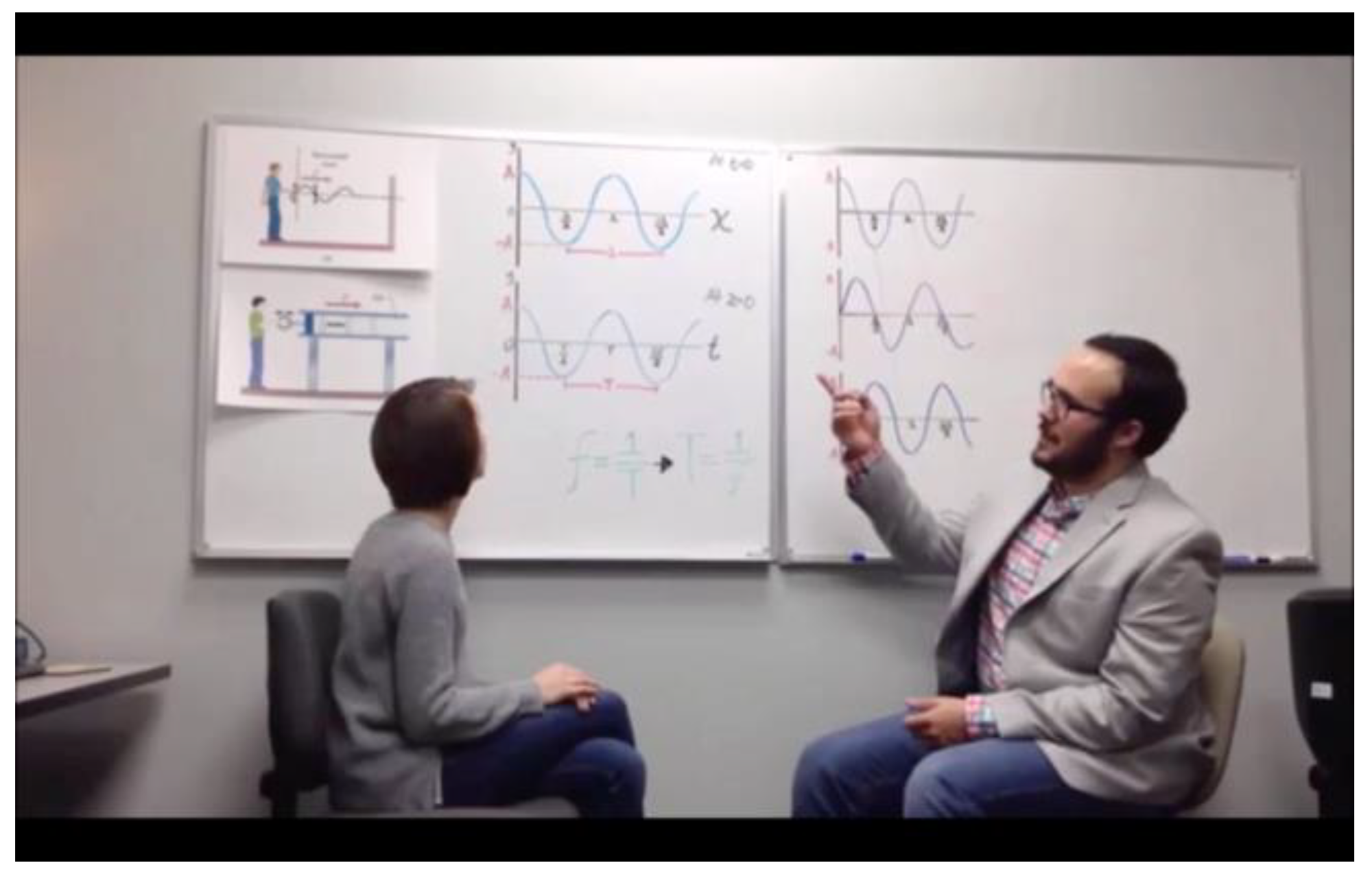
Disclaimer/Publisher’s Note: The statements, opinions and data contained in all publications are solely those of the individual author(s) and contributor(s) and not of MDPI and/or the editor(s). MDPI and/or the editor(s) disclaim responsibility for any injury to people or property resulting from any ideas, methods, instructions or products referred to in the content. |
© 2024 by the authors. Licensee MDPI, Basel, Switzerland. This article is an open access article distributed under the terms and conditions of the Creative Commons Attribution (CC BY) license (https://creativecommons.org/licenses/by/4.0/).
Share and Cite
Sullins, J.; Turner, J.; Kim, J.; Barber, S. Investigating the Impacts of Shame-Proneness on Students’ State Shame, Self-Regulation, and Learning. Educ. Sci. 2024, 14, 138. https://doi.org/10.3390/educsci14020138
Sullins J, Turner J, Kim J, Barber S. Investigating the Impacts of Shame-Proneness on Students’ State Shame, Self-Regulation, and Learning. Education Sciences. 2024; 14(2):138. https://doi.org/10.3390/educsci14020138
Chicago/Turabian StyleSullins, Jeremiah, Jeannine Turner, Juhee Kim, and Steven Barber. 2024. "Investigating the Impacts of Shame-Proneness on Students’ State Shame, Self-Regulation, and Learning" Education Sciences 14, no. 2: 138. https://doi.org/10.3390/educsci14020138
APA StyleSullins, J., Turner, J., Kim, J., & Barber, S. (2024). Investigating the Impacts of Shame-Proneness on Students’ State Shame, Self-Regulation, and Learning. Education Sciences, 14(2), 138. https://doi.org/10.3390/educsci14020138










